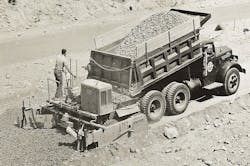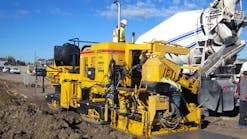Stone spreading has been practiced since the first surfaced roads were built. The earliest mechanization of the task was for carts or wagons drawn by animals or human labor to deliver the material, which more laborers would shovel out and spread. End- and bottom-dump wagons evolved from the carts. Originally, the wagon was tipped or the bottom gates opened with no control for the rate of discharge, and eventually a means was developed to gradually open the bottom gates to release a desired amount.
With the advent of dump trucks in the early part of the 20th century, controlled spreading of stone could be achieved through chains or cables to hold the tailgate slightly ajar, or by attaching a steel box to the rear of the chassis or dump box. Such practices continue today.
One of the earliest known free-traveling spreaders was the Charles Hvass & Co. No. 1S Spreader. Drawn by two horses or a small tractor, it consisted in a 2-cubic-yard hopper over a revolving spreading cone. The cone was turned by a vertical shaft that also stirred the contents of the hopper, and the shaft was powered by chain from the back axle. It could handle anything from dust through 1-1/4-inch stone, casting it 8 feet wide to 1/2 inch thick, or more thinly twice as wide as the operator controlled the rate of flow to the cone.
The development of modern machines for different spreading applications began in the 1930s with the first self-propelled spreaders. These free-traveling (as opposed to form-riding) machines could be mounted on wheels or crawlers, and could handle asphalt or stone.
The Foote Concrete Machinery Co. of Nunda, New York, introduced the first self-propelled spreader in 1932. It was offered through its Adnun (Nunda spelled backwards) Engineering Division. It consisted of a hopper with side arms that rested on solid rubber wheels, with an operator’s deck and a power unit. While the asphalt version was driven by a pair of roller drums, the stone spreader had a pair of dual tires on the rear. Cables or chains could be attached to the dump truck’s frame to help propel the spreader and keep the two vehicles in sync. This concept would advance to manual truck hitches and later to automatic coupling and decoupling hitches. Notably, the asphalt version had problems staying on the paved surface without marring or rutting it, but Adnuns became quite desirable for laying heavy stone base courses.
Jaeger Machine Co. marketed its late 1930s bituminous paver and adjustable spreader as being adaptable, like the Adnun, from asphalt to stone and aggregate work. It also offered SPS-1 and SPS-2 self-propelled stone spreaders in the 1940s and 1950s; the hopper widths were 8 feet on the SPS-1 and 9 feet on the SPS-2. Minimum spreading width was 5 feet. The SPS-1 could spread up to 16 feet wide, the SPS-2 to 27, and both were available on crawlers or four powered pneumatic tires.





